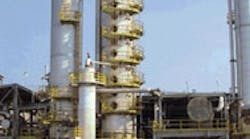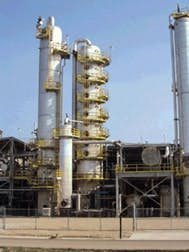In 2001, AG Processing Inc. (AGP) of Omaha, Neb., a farmers' cooperative that produces, among other things, fuels-grade ethanol, had a problem. The beer mash tower at its corn processing facility in Hastings, Neb., was performing poorly.
The tower separates the "beer" into overhead vapor, consisting of ethanol and water, and bottoms "stillage," consisting of the majority of the water and fermentation solids.
It takes a feed stream consisting of a combination of ethanol, proteins, fibers, sugars and other trace chemicals in water from the fermenters. The feed enters the top of the tower, where the ethanol is stripped out of the water/solids mixture and sent to other towers for purification.
In the Hastings operation, the bottoms stillage stream had a very high alcohol content. Ethanol concentrations as high as 0.14 volume percent to 0.2 volume percent ethanol were observed at normal production levels; a typical specification for this stream is no more than 0.02 percent.
In short, the facility was losing a lot of valuable ethanol it could be selling. Solids also were building up inside the tower, further damaging its efficiency. Furthermore, alcohol was going into the plant wastewater, complicating its cleanup and adding to expenses there, says Darcy Ehmann, AGP's technical services manager. Clearly, the company needed to improve the tower's efficiency.
AGP went to process engineering products and services provider, La Porte, Texas-based Sulzer Chemtech USA Inc., for help in analyzing the problem and providing a solution.
Performance of the beer mash tower at AGP's Hastings, Neb., facility was improved 27 percent when Sulzer Chemtech revamped its distilling trays.
Inefficient trays
The beer mash tower in question is 138 inches (in.) in diameter and contains 22 single-pass trays spaced 29.5 in. apart. They were originally supplied as fully welded-in, post-supported large-hole sieve trays, but were modified into ring-supported trays prior to their installation at AGP. The four large pipes that had served as downcomers had been removed. The 25-in. round openings were left in the tray deck, and downcomer bolting bars and plates were added.
The tray deck area remained unchanged from the original design, with the same sieve perforation pattern and 18-millimeter holes. The tower also had a relatively short flow path length of 54 in. for such a large-diameter (138 in.) tower. As designed, the tower had a lot of "wasted" space.
Sulzer Chemtech and AGP began their studies by evaluating the existing conditions in the beer mash tower. They determined the tray efficiency was only 48.1 percent.
The question was: Why?
"Sometimes when impurities build up in the tower, it is flooding ," it's at its maximum capacity," says Dan Summers, manager of chemicals and gas applications at Sulzer Chemtech and leader for the AGP project. "Since it wasn't at maximum capacity, the only thing I could attribute the poor performance to was that there just didn't seem to be enough efficient contacting on the existing trays to make a good separation."
A different kind of tray
Sulzer Chemtech considered a number of options for revamping the tower and finally settled on using its V-Grid tray ," with a difference. V-Grid trays have been used successfully in more than 30 beer mash towers worldwide, but unique conditions at the Hastings tower led Summers and his team to make some additional modifications.
First, the pipe downcomers were replaced with full segmental downcomers, which added flow path length to enhance the tray efficiency. In addition, Sulzer Chemtech's Mini Jet Tab (MJT) "push valves" were placed strategically on the tray decks to help push the liquid around the periphery of the tray to eliminate stagnation. These valves, placed at the tray inlet, outlet and around the periphery of the V-Grid trays, provided a forward thrust of vapor on the tray, imparting momentum to the downstream liquid.
The 27 percent solution
These modifications, which were installed during a seven-day shutdown in May of 2002, improved the efficiency of the tower by 13 percent ," up from 48 percent to 61 percent. The increase in tray efficiency (Murphree efficiency) is 27 percent. AGP also saw a significant improvement in run-length time, which is attributed to the fouling-resistant characteristics of the solution. AGP's Ehmann says the payback time for the improvement was about one year.



